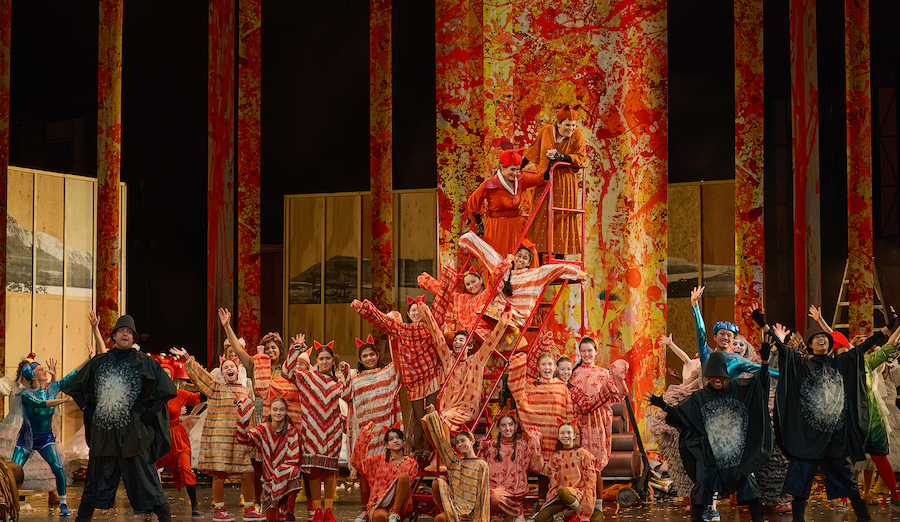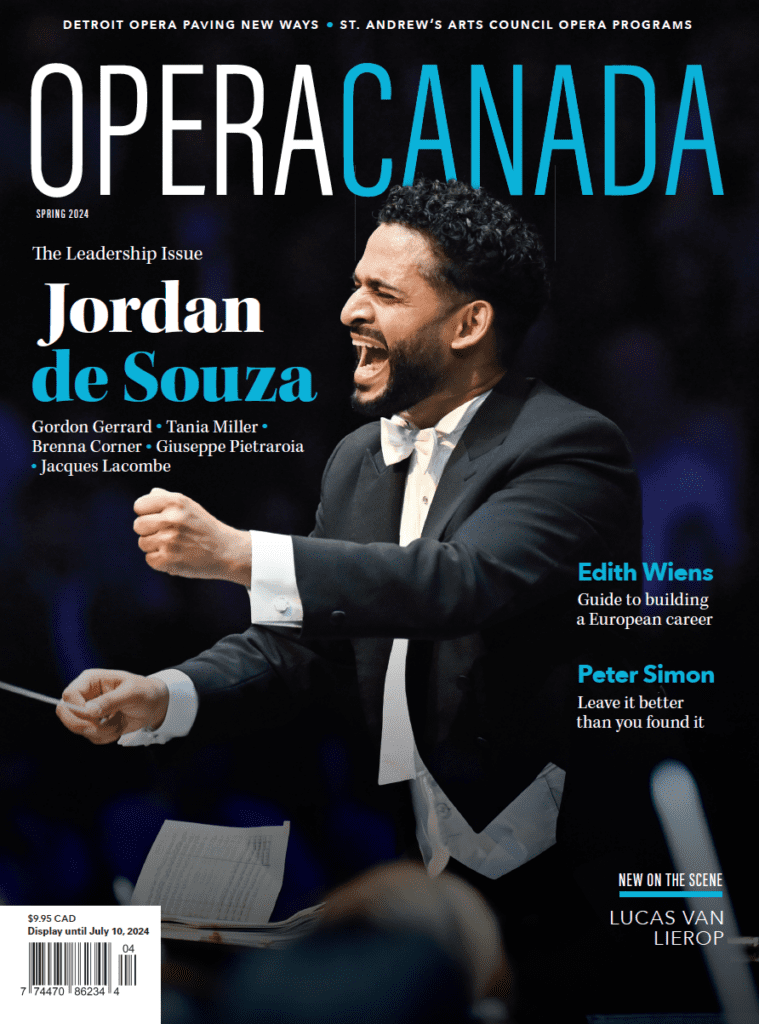Leoš Janáček’s The Cunning Little Vixen (Jan 26, 28; Feb 3, 8, 10, *13, 14, 16, 2024), returning to the Canadian Opera Company (COC) for only the second time, and twenty-five years after its last staging in 1998, has that rare quality of an opera that captures, in a mere eighty-five minutes, the depth of humanity’s relationship to nature in all its frustrations and juxtapositions. Retreating from the wintry chill outside is to enter not exactly a green and pleasant land, but a forest teeming with life in all its sorrows and joys.
Jamie Manton’s direction brings a fresh interpretation to the opera’s multitudes; I was fortunate to see the production open at the English National Opera in February 2022, and its COC debut did not disappoint. It’s a visual feast: Tom Scutt’s set and costumes are peppered with strong doses of whimsy, a rampage of frill, fluff, and bright colours, but even if it verges on the silly sometimes, pantomime this is not. Exaggerated appearances are all carried off in the manner of representing the very strangeness and incomprehensibility of life itself; the microcosms of birth, love, and death into which we peer through this forest are charmingly absurd, not unbelievably ridiculous.
Some Vixen stagings tend towards childlike fantasy; others lean deeply into a grittier, darker interpretation. This production occupies a middle ground, where the idiosyncratic traditions of self-irony, surrealism, and absurdism that permeate Central and Eastern European art of the first half of the twentieth century emerge alongside folkloric visual tropes. Cutouts of black-and-white photographs of natural scenes on the large wooden blocks on stage—sometimes backdrop, sometimes turned around as hen house—evoke memory and nostalgia. Long painted cloths, often with aesthetic hints of the 1920s avant-garde, periodically unfurl vertically, presenting us alternately with beautifully illustrated seasonal changes and symbolic representations of the opera’s core themes: life cycles, conflict, love, death, and man’s attempt to dominate and control nature.
Being conceived and written just a few years after the catastrophe of the first World War and the new formation of Czechoslovakia, there is plenty of room to interpret how these events shaped Janáček’s approach to the themes of humanity’s relationship to nature, and to itself. Rather than the astringent political satire that we might associate with other modernist animal fables such as Orwell’s Animal Farm, this production aptly captures the opera’s tendencies towards pensive reflection that yield to sporadic bursts of intense emotional expression. The exposed inner workings of the theatre on which the curtain rises has a vague flavour of the post-apocalyptic that soon gives way to autumnal warmth. But some of this unease remains throughout, acting as a philosophical counterfoil to the rustic playfulness represented by the cast of quirky creatures that frolic through the plot.
Such binaries are also apparent in the ensemble of black-hatted (silent) chorus members, acting as stagehands that also signal transitional moments, almost as Brechtian heralds. Sometimes seeming to be augurs of doom—especially when their entrances coincide with rather darker musical moments—they also break into exuberant choreographed routines, encapsulating the signature surreal qualities of this production. I took great delight in two aspects that lent a particularly British quality that I hope will translate on this side of the Atlantic: the (perhaps unintentional) visual parallels of the toadstools’ thickly-ribbed bodies with cricket whites—what signals rustic village life more than cricket, after all!—and the double-entendre implied by the hens in extravagant frothy white dresses (the “hen do” being our term for a bachelorette party).
Under Johannes Debus, the orchestra was agreeably elastic, consistently maintaining the keen alertness and precision that Janáček’s often finicky rhythms demand, and relaxing nicely into expansive, lyrical passages. One of the challenges of Vixen is its relatively high proportion of orchestral interludes, and on occasion the balance between filling these passages with onstage action and visual spectacle—ballets, and so on—and allowing for calmer scene changes was slightly askew, but on the whole there was enough momentum to carry us through.
Jane Archibald fizzed with energy in the title role, sprightly both physically and vocally, leaping around the stage and tackling the signature speech-rhythms of Janáček’s vocal writing with a meticulous care that never sacrificed tone quality. She grasped the bigger moments estimably, too, particularly shining in the passages of Act II where, as Vixen falls in love and reflects on her life’s journey so far, Janáček’s score slips into almost Puccini-esque lengthy, lush lines, a more dramatic lyricism very reminiscent of passages in the earlier Jenůfa. Ema Nikolovska, making her COC mainstage debut as the Fox, provided a worthy mezzo counterpart to Archibald, while Alex Halliday (Poacher), Wesley Harrison (Schoolmaster/Mosquito), and Giles Tomkins (Priest/Badger) all sang well in supporting roles, and the large cast of children performed admirably—Emma Moreau in particular had a strikingly clear projection as the young Vixen.
Special mention must go to mezzo-soprano Alex Hetherington, who stepped in on the day for the role of Lapák the dog , covering for an indisposed Carolyn Sproule. Resplendent in the giant, wobbling grey orb that is the canine costume, she was memorable not only for the feat of staying upright throughout, but more importantly for a wonderfully rich, warm sound (catch her again on Feb. 13, for the COC’s Relaxed Performance).
Christopher Purves rarely disappoints, and had all the necessary jaded and grumpy qualities of the aging Forester while bringing a rich sensitivity to the role, most notably in the final scene, where he is left alone to muse on his life and the vagaries of human experiences as spring begins again. Here, renewal and rebirth come with a bittersweet uncertainty: the humans cannot seem to extricate themselves from their regrets, but the colourful cast of shiny creatures returns, carrying on as they always have. A new generation lives out their days among the humans; the Dragonfly, who Manton conceives of as a kind of “spiritual ancestor, an observer,” quietly returns again. Natural life goes on with or without us, but we are never far from the consequences of our actions as temporary inhabitants of Earth.
Related Content ↘
Opera Canada depends on the generous contributions of its supporters to bring readers outstanding, in-depth coverage of opera in Canada and beyond. Please consider subscribing or donating today.







